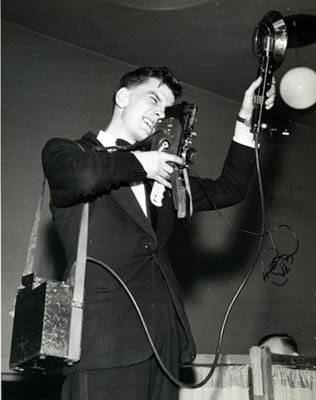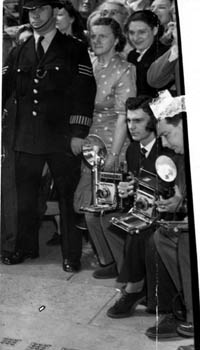Peter Smith ex Fleet Street photographer and photo editor has contacted the PPHP from South Africa where he is retired…. he still shoots for pleasure and loves his life in SA. He is back in the UK next year to visit family and will be fitting in a visit to a Fleet Street pub with friends..the PPHP is looking forward to a few beers and more memories.. Here is his story:
My life in Fleet Street By Peter Smith
It was a cold grey November morning in 1949 when I stepped off the train at Chancery Lane Station and made my way down Shoe Lane in to the hub bub of Fleet Street. Even at that time in the morning it was a hive of activity. Lorries loaded down with giant newspaper rolls off loading them at the back door of the national newspapers ready to go on the presses. Dodging between the newspaper vans delivering the first evening editions became an art that one had to learn very quickly!
After negotiating a few bundles of papers thrown from the vans I ran in to Salisbury Court and found the entrance in an alley way leading to St Brides Church and gingerly poked my head around the door. “Come in lad, just don’t stand there” came a friendly voice peering over a newspaper. It was Mr Jones, Picture Editor, Jonah, as he was fondly known by his colleagues and whom I had met the week before during my interview. I was introduced to the head messenger boy, “he will show you the ropes”; he said and left to carry on with his work. And so I started my career as a messenger boy with the Associated Press Photos at the age of sixteen earning the princely sum of £2.10 shillings a week. One of my priority duties was to get a regular supply of tea for the photographers who had just come back from an assignment. Boy! Get the tea-I would grab an old enamel jug, the photographer would give me sixpence and I would go across the road to Manzies and get the tea as well as thick buttered cheese rolls.
I had taken an interest in Photography at the age of fourteen when I bought a second hand camera in a junk shop and was determined then to someday be a press photographer and where better to start, Fleet Street the hub of the newspaper industry.
AP Photos
AP Photos, the American agency, were at that time housed in a ground floor room at the back of the Press Association/Reuters building at 85 Fleet Street. They had been bombed out of their offices during the war and were awaiting completion of their new building on a bomb site in Farringdon Road conveniently situated next door to the Hoop & Grapes.
I sat on a wooden bench with other messengers who began to explain to me my duties. Photo agencies supplied news and pictures to the newspapers. At that time there were a number of them, some specialising in sport, others fashion, but the majority dealt in hard news gathering, AP, Press Association/ Reuters Photos as it was known then, (it was later in the sixties that Reuters broke away and had their own independent photo agency). Planet News, Keystone, London News Agency (LNA), International News Photos (INP), Barrats, Sport & General to name but a few. The competition was fierce as in those early days one was only paid by their results; contracts with newspapers were still in their infancy.
RUNNER BOY
My task as a runner boy was to try and get pictures round to the newspapers picture desks before the opposition. Many a time, when you met up with one of the opposition boys you would try and grab his photos and push them down the nearest drain.
Most of the agencies worked on sale and return and it were usually the first picture on the picture editor’s desk that would make the sale. The editor would sign for the picture, which meant the agency would recoup a print fee and if it was used in the paper then a publication fee would be paid according to a scale, depending on the size of the picture, 12 sq inches, 30 sq inches, 50 sq inches and so on.
Racing against the clock!
Besides all the National Dailies there were three main evening newspapers, The Star, Eve. News and Eve Standard.It was nothing for them to have as many as six editions each, the editors hungry to fill them with pictures and with deadlines to meet there was always this constant rush to get the pictures round to them as fast as possible.
We were now in our brand new building in Farringdon Road, the photos department in the basement. Colonel Butler was bureau photo chief, a pipe smoking American with a broad accent, “Saaaay Smitty”! as he would greet me, “how’s it going”?
KING’S FUNERAL
My early recollection of major stories was King George V1 funeral. I was asked to help the photographer, by carrying his equipment, ladders for elevation, plus his heavy camera bag. We were at our position outside the Abbey at 5 o’clock in the morning to beat the crowds of sightseers that had already started to arrive. The photographer poised on his ladder, waiting for the moment of the procession to pass. This would have been about 11am, six hours of waiting!! He would then hand me the slide, (one would have been lucky to have managed to get off two exposures), no such thing as motorised cameras! I then dashed to St James Station and on the tube to Blackfriars and ran as fast as I could to the office.
The “RUSH”!
“RUSH”! I would shout as I entered the photos department. Everything would stop, the despatch clerk would time stamp the moment I came in. A darkroom technician would grab the slide and disappear in to the darkroom, it would take about two minutes to develop the plates, and the developers would have been warmed up ready before hand. As soon as the plate was fixed a bell would ring and the picture editor would view the wet negative through a light box, he would then shout out instructions on how many prints he would want, on something as large as the King’s funeral, hundreds of prints would be made.
But first, just three quick prints would be done for the evening paper editions, the Star, News, and standard. Usually 10×8 inches prints would be made, but could be as big as 15×12 if it was a good picture.
The printer would set up the negative in his enlarger and make three prints, the developing boy would develop and fix them and throw them out into a tank of water where again boys would be ready to give them a quick wash, the boys would then dash round the papers. The despatch clerk would time stamp the last boy out and the whole operation would take about seven minutes, if it were longer then there would be an inquest the next day.
Print drying!
There were wonderful methods of drying in those days. For prints that were going abroad or to magazines, these could be handled with more care and washed thoroughly. The prints were put on glazing machines, these were huge heated drums with a high polished chrome surface and the prints would be put on a conveyor belt and would come off all beautifully glossy. To keep these drums clean we used to use amylasitate, it smelt like pear drops, you always knew when you were in a photographic department with that constant smell.
Or just set fire to them!
The other method of drying was ‘roughdrying’, a large heated drum with just a cloth conveyor belt. But even that took too long when it came to a Rush. So the wet prints would either be put between sheets of blotting paper and the boys would take off round the papers, or some would go to the extreme and soak the prints in methylated spirits and hold them over a gas ring. God help you if the print caught fire and had to be done again, you would get a clip around the ear from the printer, never mind that your hand and arm might be on fire! Can you imagine the Health and Safety people allowing it to happen today?
Worldwide distribution
Not only was it the job of the agency to feed the National newspapers, but papers in the provinces and abroad. Packets of photos taken that day would be despatched by train to the provinces from Euston, Kings Cross & St Pancras. It wouldn’t be the first time I had to run down the platform as the train was leaving and hand the guard a bundle of envelopes for Manchester, Glasgow or Birmingham. Despatch riders were also employed to collect film from photographers or take packets of pictures to airports. Croydon was still operating at that time with Flights to Europe.
For major stories pictures would be sent or received by a wire photo machine. Dedicated telephone lines in to newspaper offices in Europe could receive photos within minutes and have them in their papers that same day. For countries like Australia, Russia, New York, pictures would be sent by Radio and picked up or delivered to Cable & Wireless situated on the Embankment.
I was now responsible for checking for publications in all the newspapers, not just the National evenings and dailies, but all 180 odd provincial newspapers that had offices in Fleet Street from the Dundee Courier to the Birmingham Post & Mail.
I was given a small suitcase full of picture files and would wade through all the editions to find any outstanding publications. These would be duly noted and handed to the accounts department for payment. It was a frustrating job, but on the good side the hours were 9-5 with weekends off allowing me to get out and take pictures in my own time.
Taking my first pictures.
I had bought my first press camera a second hand 9x12cm Palmos plate camera (which I still have), and was eager to get out and prove that I could take pictures.
I had learnt very quickly that if you wanted to get on you had to prove to the picture editor that you were capable of standing up to the pressures of the job. It was no good thinking they would hand you a job as press photographer there was far too much competition amongst us lads for that to happen.
It was a question of badgering the Assignment editor to send you on anything, a football match or film premieres which were quite popular in those days. The London Zoo was another favourite just to try and get something unusual. This meant buying him a drink in the Hoop & Grapes and many a night I had slithered off the bar stool and curled up on the floor!
I recall the first football match I was allowed to cover it was Millwall, no such luck to get the big games they were reserved for the senior photographers.
Undaunted I set up my position ten yards from the goal post alongside other photographers and trying to look the part and not be nervous.( Yes those were the days when you could sit along the goal line).
At half time after having exposed a few plates I dashed back to the office with what I considered were the best pictures of the day. As I sat on the train I visualised my pictures in all the Sunday papers! How wrong could one be and what a shock was awaiting me! I went in to the darkroom and carefully developed my precious images and rang the bell for the picture editor to come round.
“What the hell have you got Smith”, was the curt greeting I received. “Some good football pictures Sir”, I meekly replied. “Humph will see about that”! He held up my precious glass plates to the light box and slowly and deliberately one at a time dropped them crashing to the floor, muttering on his way out, about young upstarts wasting his time.I was left to pick up the pieces of my ego and the remnants of my afternoons work besides receiving a clip around the ear from the darkroom chief for messing up his nice clean floor.
It could have been easy to have given up, but I was determined to carry on until one day he begrudgingly said, “I suppose that’s not bad Smith” and the picture was issued. That was the start of getting on the first rung of the ladder; the next step was to get a publication! Only a small minority of pictures issued would appear in the papers.
The Darkroom
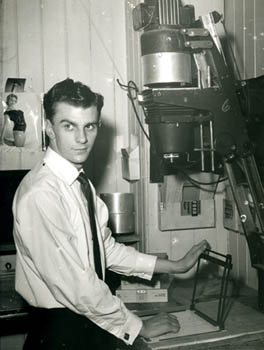 A vacancy had occurred for a developing boy in the darkroom and although it meant back to shift work again it gave me another opportunity to learn some darkroom skills.
A vacancy had occurred for a developing boy in the darkroom and although it meant back to shift work again it gave me another opportunity to learn some darkroom skills.
Developers and hypo’s, in those days were made up by the developing boys, awful potent stuff that would stain your finger nails brown. Each office would have their own jealously guarded recipe. Sodium Carbonate, Metol, Hydoquinone, Potassium Bromide and Hypo, (Sodium Thiosulphate), to ‘Fix’ the negative or print. Large demijohns were used to store the solutions.
Film/Plates
Back in the late 40’s early 50’s the fastest plate was 200 ASA; they came in boxes of 12, packed back to back. You had to fiddle about in the dark and make sure the emulsion was facing the right way when you put them in the slide. One way of testing this was to lick the corner of the plate with your tongue; if it was sticky then it was the coating on the back. Later 5×4 cut film came in to use, Kodak Tri-x Panchromatic sheet film; Panchromatic Type C; ASA 200 daylight; and ASA 160 in Tungsten lighting were the norm. This had a little notch at the bottom right corner so you would know which way the emulsion was facing, progress indeed!
The important thing was to obtain an image and if it meant heating the developers up so be it, but not too much that it would melt the emulsion as you would be in trouble again.
The enlargers were huge horizontal contraptions, made of good old mahogany, with brass lenses and huge ten-inch condensers, some still had their arc lighting, that hadn’t yet been converted to electricity. It was built on runners, which could easily slide back and forth, depending on the size print you wanted to project on to the easel. The bench could also be used as a bed if you missed the last train home!
THE CORONATION
The next major story to come along was the coronation. I can remember developing literally thousands of prints. We would virtually be working round the clock and would sleep on the enlarger benches; there was no chance of going home.
A move in the right direction
I was becoming frustrated and feared I could spend the rest of my life in the darkroom if I didn’t do something about it. Many of my colleagues opted to go freelancing, but I didn’t feel confident enough to do that just yet.
An opportunity arose to be head of darkroom at International News Photos, (INP), in Shoe Lane an increase in my wages was also an incentive for moving. The work was very similar to AP darkroom, but I had more opportunity to go out and take pictures.
My first real break came one evening when I was on late shift in the darkroom. It was September 1956, a call came through that Marilyn Monroe was at the Palace Theatre with her husband Arthur Miller for the performance of the Berliner Ensemble. This was her first public appearance since the announcement of her illness and since she stopped work on her film. There were no photographers around and so I was told to go and get a picture of her. It was the interval and I was waiting for her to take her seat and as she appeared I got a picture of both of them. The daily Express paid 20 pounds for the picture, three times what I earned in a week. The next morning, Ted Taylor, the boss called me in to his office and said I did a good job but would not pay me any of the money, as I was not officially yet a photographer, tough times!
There were a lot of chances to take visiting stars, in the early fifties, Bridgette Bardot, ,Zsa Zsa Gabor and many others. Another opportunity came one evening when I received a call at home that Liz Taylor and her husband Richard Burton were in my local pub! Burton was having a quiet drink with his niece who was getting married the next day. I slipped along to the pub and took a shot of all three of them sitting quietly in the corner. The next day was the wedding and every photographer from the ‘Street’ was outside the church.
I still felt at that stage I wasn’t getting anywhere fast. I was keen and impatient and so I made the decision to leave Fleet Street and go and work on a new Westminster Press/ Thomson evening paper in Slough as Chief Photographer.
 PA
PA
Then in 1973 the opportunity came for me to go back in to Fleet Street and to take up the post as assistant picture editor at the Press association. It was ironic that I was about to step in to the same building and only across the archway where I first started in 1949 where AP was housed and was now the PA Library. This time I went in the front entrance of 85 Fleet Street with its grandeur marble entrance
Now I was back in the mad house again, where the pace was a lot quicker. It took some time for me to adjust having been away from the real action.
BOMBING
It was the time of the IRA bombing of London and one of my duties was to be on standby call during the night, at home, in case of any major stories breaking. I hadn’t been at PA long when the phone rang at 3 in the morning it was the night news editor.
Now he was one of these very abrupt excited types and the conversation went something like this. Remember I was still half asleep. “Hello”! “A bomb has gone off in Regents Street”! Bang went down the phone. I thought now have I dreamt this or did someone say something. So I phoned the office back to confirm what he said and I got the same curt message “Don’t you listen, a bomb’s gone off in Regent St I haven’t got time to talk to you”.
So I am now left with the decision to get a photographer out of bed in the middle of the night to wander down Regent Street and see if anything had happened and report back to me if it was serious. At the height of the bombing campaign this would happen about two or three times a night, no sooner had you dealt with one explosion and another would be reported the other side of town and remember one had to be back on duty in the office by 8 the next morning. This was my initiation back in to Fleet Street.
DUTIES
Being a picture Editor was a totally different kettle of fish than being a photographer. Both had their responsibilities but it was the duty of the picture editor to assess a situation and decide whether it was worth covering, (a) because of its news value and (b) cost value. The latter was the hardest decision to make. To try and explain to the editor in chief, at conference the next morning, that you had spent a few thousand pounds that night, on a story that hadn’t materialised, was not the best way to get in to his good books. But Woe be tide you if you had decided to ignore the story and turn over and go back to sleep, only to find the next morning the papers were full of pictures of the incident. Only Editor’s in Chief are allowed to have hind sight on their side!
CUP FINAL… and can’t see a thing!
I can remember the first time ‘I went out’, in charge of a team. It was to the Cup Final at Wembley. Unions were very much in control, which meant, besides the photographers, a darkroom technician had to come along to process the films and a wireman to send the pictures across on a dedicated telephone line and back to the office.
I was trying to make an impression that everything was under control and wanted it all to go smoothly. The others of course had done it many times before and just looked at each other as much to say he will learn.
This may sound very exciting going to a Cup Final, but I can assure you will be lucky if you see a ball being kicked.
Our darkroom was in the famous round towers, right at the top of the stadium, (now sadly demolished to make way for a new stadium). We had to climb with all our equipment up a twisting iron staircase to the roof.
Apart from not being able to see what was going on we were also at the mercy of the pigeons. We had our own darkroom, which was about the size of one of those old-fashioned police boxes, or a Dr Who Tardis..We had a portable table for the wire machine and a table for my typewriter.
The idea of all this was to get pictures out to the papers as quick as possible. It would have taken far too long for even a despatch rider to get back to Fleet Street through the London traffic so it was quicker to wire the pictures back. Again we are talking about meeting deadlines and some of the evening papers would have a late Cup final edition, allowing an early picture of the game to go in the paper along with the
report.
The kick off was 3 0’clock and it was imperative that the photographers had a picture of sorts in the first five minutes. A boy would be standing by to take the film from the photographer and run like mad to us in the roof where we would be waiting to develop the film, I would then select the negative to be printed and the wireman would send it across. The first picture had to be in all the newspaper offices by 3.30
otherwise all hell would break loose.
It was coming up to 3 0’clock and the teams were about to come out. We had set up the equipment long before and now would be eagerly awaiting the first pictures when I could hear my wireman trying to speak to the office,” Hello PA! Hello PA”! So I ambled across and in a high pitch nervous voice and trying to stay calm said is everything ok? “Nope can’t get thru to the office ain’t got no line” and he sat down and
arried on reading his Mickey Spillane novel. “So what are you going to do about it I screamed”? He looked up at me “nuffink ain’t my problem” and buried his head back in the book. I flew down three flights of stairs to the nearest pay phone and phoned the office,(no cell phones)! I was now in a state of panic. “We haven’t got a line through I shouted”.
What has to happen, most newspapers and agencies have a dedicated line already installed at all major venues. It is then just a matter of speaking to the company a few days before the event to ‘book the line’ as it’s called. Someone had forgotten to do this. So there were frantic calls to get this fixed up.
The line came through just as the runner boy came up the stairs with the film so in the end all was well. But if you ever have a constipation problem believe me this sort of crisis will soon sort the bowel movement out, better than any tablets.
A few years later we moved our darkroom nearer the pitch, this was a great improvement. Instead of having to run up flights of stairs we were only a few yards from the goalmouth. This of course made it easier and quicker to retrieve films from the photographer and to save vital minutes. The problem and there was always problems, was that before we had to dodge pigeons now we learnt we were directly beneath the toilets and during half time the toilets would overflow and seep through the sealing. It is quite difficult to type holding an umbrella over ones head at the same time. It certainly brought home the saying being Shit—0N—from a great height!
ANYONE FOR TENNIS!
Wimbledon fortnight was similar. We had a darkroom under number two court. There would be a team of eight photographers covering the courts, a wireman, darkroom technician an assistant editor and me. During the fortnight we would get through 400 rolls of 36 exposure films, each neg would be scrutinised through a magnifying glass, no time to make prints, and then wired back to the office and round the
World.
Once the unions had gone in the eighties the developing and wiring was left to either the photographer or the picture editor. By then new technology was in and we were using colour film.
LOCKERBIE
Other on the spot decision, which comes to mind, was the Lockerbie disaster. We all know where Lockerbie is now, but when you receive a call with scant information that a plane has gone down in a town called Lockerbie, you think where on earth is Lockerbie?
It was nine in the evening and most of us were soon thinking of bed, no chance of that! A frantic look on a map to see that our nearest photographer was in Glasgow. So I sent him on his way to assess the situation. In the early stages, you don’t know whether it is an airliner, a small plane, or an RAF fighter that’s gone down. You are desperately searching for more information and from home it’s not an easy thing to do.
The main information always comes from TV bulletins and one can quickly start to assess the situation. It soon became obvious that it was big! So I then sent our next nearest man, in this case from Manchester to get up there fast! Then all hell broke loose with bulletins and calls stating that an airliner had gone down on a village. You start to phone every possible photographer, freelancers, anyone who can take pictures, promise them the earth, pay them a fortune, but get up there! The next thing is to organise your own staffers from London to start making their way to Lockerbie. Hotels have to be booked, telephone lines laid on, darkroom facilities have to be found. All costing big money and has to be accounted for. You can’t budget for a situation like that.
POPE’S VISIT
My next challenge I was asked to organise the photographic positions for the Pope’s visit to Ireland and Britain in 1982. This was a major task, it meant me travelling the length and breadth of England, Wales and Scotland to visit the towns the Pope was going to visit. Having meetings with the local constabulary and council officials, walking round the sights and suggesting where we wanted our photographic positions. Having to travel all over Ireland and doing the same there, talking to the Bishops and arranging positions.
KEEPING UP WITH HIS HOLINESS
The two major problems with something like this, where you have the Pope visiting lots of different places in a day, was trying to keep up with him.
He was ok he just jumped in to a helicopter and made his way to the next venue we had to pack up all our equipment and drive like mad to get there. Of course this was impossible so I had to organise three teams all leap frogging so we would always be one jump ahead of him.
DUBLIN AIRPORT
I remember I was in Ireland and our first task was to cover the Pope arriving at the airport and kissing Irish soil. We had a position on the roof of the car park with the make shift darkroom two floors down. All this had been arranged with the blessing of the local Garda and authorities weeks before.
At 4 0’clock in the morning we arrived at the gate of the airport only to be met by a police officer who had never been told about us having a position on the roof and was in no way going to let us in. It was stomach- churning time again and I didn’t fancy rushing to the toilet, so after a few choice words he reluctantly let us through.
One of the ploys used to get film from a high building to the ground floor was instead of rushing down the stairs and breaking ones neck was to devise a bucket on the end of a fishing line and lower it over the side. This works fine providing you know the opposition is not lurking somewhere on a floor in between, otherwise there would appear a hand clutching a pair of scissors cutting the line and you watching your films going to the bottom.
KNOCK
Our next port of call was the small village of Knock on the West coast of Ireland, where the Pope was to visit later that day. Knock is where all the pilgrims visit and is quite famous. The village consists of a church and five pubs; it now has its own airport that the Bishop managed to persuade them to build.
Security was obviously very tight, we had hired a couple of cars and we got about as far as the outskirts of Knock before the police pulled us over and said we would have to walk the rest of the way. We abandoned the cars in a farmer’s peat bog. You can imagine the farmer the next morning after a heavy night drinking saying to Paddy I don’t remember any cars!!
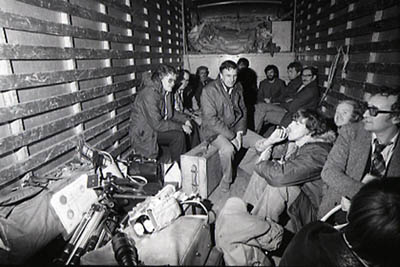 There must have been well over a hundred thousand pilgrims all wanting a sight of the pope. When it was over we had to get to Limerick further down the coast for the Pope’s visit early the next morning. We packed up everything looked outside and new there was no chance of ever getting back to the cars. We jumped on a coach which took three hours crawling through the crowds and we wound up at a railway station in the middle of the night and jumped on a train that I swear took us all the way back to Dublin to come all the way back to Limerick. We arrived at Limerick station with about half an hour to spare. Someone had thoughtfully laid on a removal van for us so we all piled in the back and got to the racecourse where the Pope was about to arrive by helicopter. As you can imagine we were quite shattered after that trip.
There must have been well over a hundred thousand pilgrims all wanting a sight of the pope. When it was over we had to get to Limerick further down the coast for the Pope’s visit early the next morning. We packed up everything looked outside and new there was no chance of ever getting back to the cars. We jumped on a coach which took three hours crawling through the crowds and we wound up at a railway station in the middle of the night and jumped on a train that I swear took us all the way back to Dublin to come all the way back to Limerick. We arrived at Limerick station with about half an hour to spare. Someone had thoughtfully laid on a removal van for us so we all piled in the back and got to the racecourse where the Pope was about to arrive by helicopter. As you can imagine we were quite shattered after that trip.
NEW TECHNOLOGY
New technology started to come in the eighties, more and more colour photographs were being used. Suddenly computers were stuck in front of us, new ways of transmitting pictures came about and it was the end of the unions after a lengthy struggle.
Newspaper bosses realised there was no need for costly print works anymore, everything was going hi tech and the newspapers started to drift away from Fleet Street to cheaper and more modern accommodation. Telegraph and Mirror moved to Canary Warf in the Docklands, The Daily Mail to Kensington, and the Express across the river to the other side of Blackfriars Bridge. The Press Association sold off their building to Reuters and moved to Victoria. The old Telegraph and Express buildings are listed and now occupied by city firms.
We were now at the forefront of new technology and it was a nightmare. I was having to travel to Paris two to three times a month to look at computers the French had designed; it was a bit like the blind leading the blind. Everybody was doing their own thing and not quite sure what the end result would be. AP had their own system that wasn’t compatible with the French, so we couldn’t send or receive pictures to each other. Then of course some of our clients were rather slow to take on the new technology, which of again slowed us up; we could only be as fast as our slowest client.
50% of the old staff had now gone but the same workload had to be carried on the shoulders of those fortunate to still have a job.
If you recall in the early days when I was covering football match at Wembley. There was a Picture Editor, a photographer or photographers, darkroom technician and a wireman to send the pictures back to the office. Now the wireman has gone and the picture editor’s roll is to wire the pictures back on this new fan-dangled machine that he has only seen once. These machines incidentally were the size of a medium suitcase and cost pounds 23000 each, two years down the line and you couldn’t give them away as doorstops.
PENZANCE
I remember my first experience with one of these contraptions. I was told to go to Penzance and wait for the Royal Photographer to come from the Scilly Isles where Diana and Prince Charles and William and Harry were spending a few days.
We had been given 12 hours notice from the Palace that our Royal photographer should be on the Island to take exclusive pictures of the royal couple and that PA were to be responsible in circulating the pictures round the world.
That was fine except there was a tube strike planned for the next day, which meant I had difficulty getting in to the office. Normally I travelled to work by tube everyday, which would take from door to door about hour and half. British Rail was still running so I had to get in the car and drive to the nearest British Rail station, leave the car and get as far as Euston. Then I had to get a cab from there to the office.
Because of the chaos we had hired a car to take all our equipment to Heathrow where we jumped on an Islander, a small plane holding about 20 passengers, which took us as far as Plymouth. From there we had hired a small 3 seater Cesna to fly us down to Penzance.
You know when you come out of an airport you are faced with a sea of faces and people holding placards up with Mr Jones, or Mr Brown, well we jumped off the plane at Plymouth and ran across the tarmac where this Biggles type character with early 1900’s flying helmet, was holding up a card with Mr smith PA. So we piled in to his plane and we hedge hopped down to Penzance, where we had a taxi waiting for us to take us to the hotel.
The photographer arrived from the Scillies about fifteen minutes later and I took his film to the nearest Foto fast centre, which of course didn’t know that they were about to develop the most important pictures of a lifetime. They thought I was bringing in my holiday snaps and said they would be ready in an hour Sir. I said no I want them in ten minutes, explained that they were very important and they would see why when they had developed the film. Of course when the film came out of the machine and they saw whom it was they just stood with their mouths open. I thanked them for their effort grabbed the film and went back to the hotel and started editing the pictures to put on the machine. All went well and now we had to get the film back to the office.
By that time I had missed the last train back to London so I had to hop on an all stations to Swindon, which got me to Swindon at 1 o’clock in the morning. I then sat and waited for a train to come in and I eventually made the office at 6 o’clock that morning. So you see it can be rather a long day!
D-DAY (PIC)
My last and biggest task came just before I retired and that was to organise the photographic positions for the Commemoration of D-Day on June 6 1994 and the following year the celebration of the end of the war.
WPA
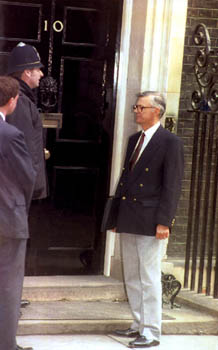 By that time I was in charge of running the photo desk and I was also the Secretary of the Wire Photo Association,(WPA), looking after the photographic interests of not only the Press Association but also the three major world agencies AP Reuters and AFP.
By that time I was in charge of running the photo desk and I was also the Secretary of the Wire Photo Association,(WPA), looking after the photographic interests of not only the Press Association but also the three major world agencies AP Reuters and AFP.
This would entail me talking with Downing Street and Buckingham Palace on all rota assignments concerning the coverage of the Royal family and the Prime Minister.
The Queen Mother’s funeral arrangements
One of my tasks was to help advice on the QM’s photographic funeral arrangements. It had come to the Palace’s notice that the QM was well in to her eighties and nothing had been arranged for a state funeral. A committee was set up with Buckingham Palace Press Officers, Police, Public Works, and members of the press representing the newspapers and agencies- NPA representing the photographic needs of the National newspapers, WPA representing the main agencies, the News Paper Society representing the Provincial Press and a representative for the magazines.
This meant we had to annually walk the route from the QM’s home, Clarence House, down the Mall, through Horse Guards, into Whitehall and on to the Palace of Westminster for her lying in state before going on to Westminster Abbey for the service. All the camera positions had to be organised along strategic parts of the route, stands had to be prepared and made ready with agreements on how many photographers to each stand depending on the size. Positions in the Abbey had to be agreed, everything being on Rota meant that the agencies had priority, newspapers next, followed by magazines and the provincial press, then the influx of foreign journalists.
This survey had to be carried out summer and winter to make sure trees along the Mall did not have to be pruned back in case they were blocking the view. Little did we know at that time that all these plans for the QM would be used for the sudden and tragic death of Princess Diana.
Best laid plans of…..!
Planning for the D-Day commemoration started six months before and necessitated in a lot of meetings with Downing St, Buckingham Palace, Foreign office officials even the Prime Minister as well as all the armed services.
It also incurred a lot of travelling around the South Coast, especially to the Portsmouth area, Eisenhower’s HQ and other sites where the Queen and the Prime Minister would be visiting.
It also meant trips across the Channel to Normandy beaches, to the port of Caen, Arromanche where the British forces landed, and where the Queen would inspect a parade of the veterans with a backdrop of some of the old landing craft.
Omaha beach where the Americans lost so many men on the first day of the invasion and to the American war cemetery, overlooking the beach with its 9000 white crosses and where President Clinton would pay his respects.
Then on to Bayeux, the British war cemetery where the Queen and President Mitterand would lay a wreath to the war dead.
All these places had to be carefully planned so as to get the best available camera positions.
Hotel rooms had to be booked, talks with the local Mayor to find rooms to develop the films and send back the pictures, access to water and power points, telephone lines had to be arranged with the local post office, and have you ever tried to doing this not speaking a word of French and they not speaking much English either.
By the time June arrived every newspaper and agency photographer knew exactly where their positions were. Some we had flying over the Royal yacht and the armada of little boats as it left Southampton waters, others were already in France, waiting for the Queen to arrive.
It is no good having the best pictures in the World if you can’t get them back to your office. You might as well throw them in the bin, (see D-Day foul-up).
As I was the organiser I had to be in France and I went across the Channel on the escort Frigate to the Royal Yacht with a Daily Telegraph photographer. We lashed our cameras on to the railings and filmed the event as it unfolded in front of us. It was a memorable sight an armada of small boats escorting the Royal Yacht out of Southampton water with world war two planes flying overhead. It had been arranged that a helicopter was to take our films off the ship and fly them back to Portsmouth, where arrangements had been made with the office to collect them. Like all well laid plans, no one had told the Captain and we carried on sailing to France with our films still in the cameras and me nearly being put in the Brig for telling the Captain in no uncertain manner that he couldn’t organise a P,.., in a brewery!
We had missed all the deadlines and as I said earlier-You could have the best pictures in the World, but if you can’t get them back to the office, you may as well throw them overboard.
We arrived in Caen quite late after finding a drunken French pilot to escort the ship up the narrow channel to the town of Caen.
We had made arrangements, on an earlier visit, to stay overnight at a Gites in the grounds of a huge Chateau, about an hour’s drive from Caen. It was a beautiful place, if one was on holiday, but all we had time to do was to get our head down and at four in the morning we loaded up the car and was on our way to our positions. I was covering the Queen and Mitterand laying a wreath at the British cemetery in Bayeux while the others made their way down to the Normandy beaches at Arromanche.
The plan was for the Queen to visit Bayeux first then she would make her way to Arromanche. After I had taken my pictures and wired them back to London, from a small office near the cemetery, we were supposed to have a coach take us down to Arromanche to meet up with the others.
You have to remember that security was tight and the police had blocked off all the roads. When we went to find the coach we were told they had gone, they hadn’t bothered to wait for us. So we jumped in to our hired car and started to drive down not knowing how far we would get before a Gendarme would stop us. We had ignored all the no entry signs and we thought our luck was holding until we came round a corner straight in to a manned checkpoint. Luckily I was still looking reasonably smart I had a blazer on and a neckerchief, loads of passes round my neck and as we drew up alongside the Gendarme I muttered veteran, Oui! (I must have looked old and tired by then) and he saluted and let us through.
I met up with the crew in a schoolhouse that we had taken over, got some good pictures of the Queen and Duke talking to real veterans and wired them back to the office.
The end of my career
June 1996 and it was time for me to leave the business after nearly 50 years involved in press photography. We had sadly said goodbye to Fleet Street and had been in our new offices for a year. Changes were all ready starting with a new editor in Chief coming in and making some drastic changes. New technology was breaking out with the advent of digital cameras, no more film, no more darkroom, just a photographer with a laptop and a cell phone sending his photos back to the office from anywhere in the World.
What of the future
85 Fleet Street was my home for so many years and carried such fond memories. The Sculpture over the front door of “The Herald” by William Reid Dick, the winged female figure seated on a globe blowing her trumpet is now silent; the grand old building is awaiting new tenants. Where I started in 1949 in Salisbury Crt now houses a fancy restaurant.
Some of the old watering holes in Fleet St still remain, The Bell, El Vinos, The Hoop & Grapes, but cater for a different clientele, but it will always remain Fleet Street to the press although they have moved on.
So what of the future- technology is moving at a tremendous pace so who can guess what is ahead of us? Some has been good, some bad with the sad closure of Murdoch’s N.O.W.
The press cameras of the 40’s & 50’s
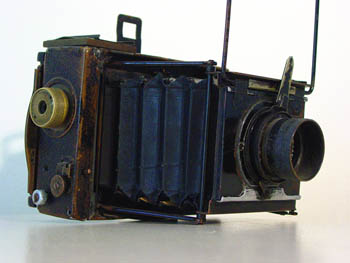 There have been press photos recorded as far back as the 1860’s, but mainly used in magazines. Newspapers still preferred the written word Most press cameras of that period and earlier where of large format due to the poor quality of the inks and paper.
There have been press photos recorded as far back as the 1860’s, but mainly used in magazines. Newspapers still preferred the written word Most press cameras of that period and earlier where of large format due to the poor quality of the inks and paper.
 It wasn’t until after the war did photos start to play an important role in newspaper publishing. Even then, compared to today’s high standards, it was just a hardly recognisable inky black smudge across the page. One of the earliest press cameras I recall on joining Fleet Street in 1949
It wasn’t until after the war did photos start to play an important role in newspaper publishing. Even then, compared to today’s high standards, it was just a hardly recognisable inky black smudge across the page. One of the earliest press cameras I recall on joining Fleet Street in 1949
was the Contessa Nettal and the Palmos, (shown here); both were 9x12cm and used glass plates.
It came with a focal plane shutter, known as a ‘Back Blind’. It had different size slits which determined how much light went on to the plate. After deciding on the right slit for the occasion, a spring would then be adjusted to determine the shutter speed, the tighter the spring, the faster the blind would travel across the plate. Focusing was mainly done by guess work, each photographer putting his own yardage on to a metal groove to determine the right distances, 2 yards, 3 yards, 5, 7, 10 and infinity. The camera was equipped with a Carl Zeiss Tessar 4.5 lens and if a flash was to be used then a Compur shutter would be screwed on to the front with a make shift triggering device that would fire the flash bulb as the shutter opened.
The Speed Graphic
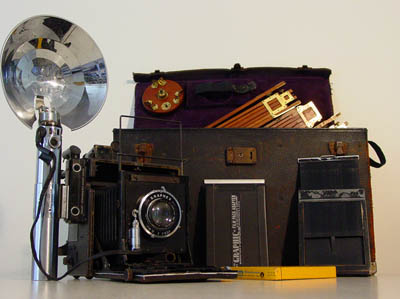 The American press had the 5×4 Speed Graphic which became the Rolls Royce of press cameras up until the late 50’s. It came in a large leather case with velvet lining and pockets to hold the mahogany tripod, 12 Double Dark slides, flash and plates. It was extremely heavy to carry around. The case had an extra usefulness, as a seat, or for extra elevation. It came equipped with a parallax view finder. built in range finder. two shutters-a ‘Back Blind’ and a Compur shutter with a solenoid attached to fire the flash.
The American press had the 5×4 Speed Graphic which became the Rolls Royce of press cameras up until the late 50’s. It came in a large leather case with velvet lining and pockets to hold the mahogany tripod, 12 Double Dark slides, flash and plates. It was extremely heavy to carry around. The case had an extra usefulness, as a seat, or for extra elevation. It came equipped with a parallax view finder. built in range finder. two shutters-a ‘Back Blind’ and a Compur shutter with a solenoid attached to fire the flash.
The Long Tom
The 48inch
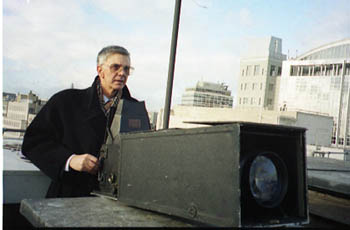 I found this old camera in the basement of PA when we were about to move out of 85 Fleet St in 1995. I and a colleague manhandled it up to
I found this old camera in the basement of PA when we were about to move out of 85 Fleet St in 1995. I and a colleague manhandled it up to
the roof and with some old film stock ‘fired’ it up. To be able to take photos from a distance during that period necessitated in a custom built camera. The Long Tom was made up from a lens off a wartime reconnaissance aircraft and bolted in to a light-tight box measuring 48inches. At the business end a Graflex body was attached to take the slide. The camera was mainly used for taking photos of the Royal Family on the balcony of Buckingham Palace from the Queen Victoria Memorial, some 300 yards away. It was also used for major sporting events-The Derby for when the horses came around Tattenham Corner, (only the one opportunity to get a shot before the horses had gone past) and Cricket at Lords and the Oval.
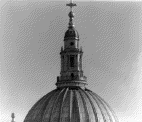
This picture of St Paul’s was taken from the roof of 85 Fleet Street, nearly 600 yards away.
—-ENDS——
This article is copyrighted to Peter Smith Some of the images of Peter may have come from PA staffers, if you notice your copyright please let me know and I will credit duly.
If you would like to contact Peter please drop me a line will { at } pressphotohistory.com and I will pass your details on.
UPDATED 1 Jan 2013:
John Broomer writes:
The following information regarding 28″ and 48″ cameras came from Mr. Ronald Hall, ex-Director of Sport & General it was written on the 18th May, 1980.
” I think the date of these to be around 1920/25 and they were purchased from First War disposal sale.
Both cameras consisted of a lens fixed onto a baseboard with supporting ribs and boxed in plywood with half plate (48″) and 5 x 4 (28″) reflex camera mounted onto the baseboard. They could have been made up by Ince Bros or Thirkettle who did work for S & G at this time.
I am not definite about any of this as I did not work at S & G until 1922 and it was some years before I became interested in cameras. I do not have a recollection of the Long Tom being at Essex Street.
50″ Telephoto purchased from Ross-Dallmeyer or Wray around 1950/55. I cannot remember now which firm made this lens but it will be marked on the lens. About this time several papers were looking for a long focus like our 48″ but it must be lighter and smaller and they got the manufacturers cracking – the result was five of these were made by above. We had one the rest went to newspapers. Only the lens was supplied, I think F200 and you had to make it up into a camera yourself. I took ours to a firm Gandolfi, a half plate stand camera specialist in Peckham. They made a baseboard and ribs to hold the lens and we supplied a half plate reflex camera to be fixed to the base. It was then boxed in with 3-ply wood. After using this for one season at Lords we re-designed it slightly substituting a metal box made by Metal Box Co.
My sister is pretty sure the two gentlemen mentioned below are sadly no longer with us…
Mark Seymour and Ken Saunders could help with more details which were based on the theory of the 48″ but less weight. I know they could help with stories of the hard work and sweat and accidents entailed in getting them into position at Lords, Leeds, Manchester, Epsom, etc.
Now when I see photographers using the latest in telephoto equipment I realise more what heroes the S & G boys were.”
UPDATED: 1 Jan 2013
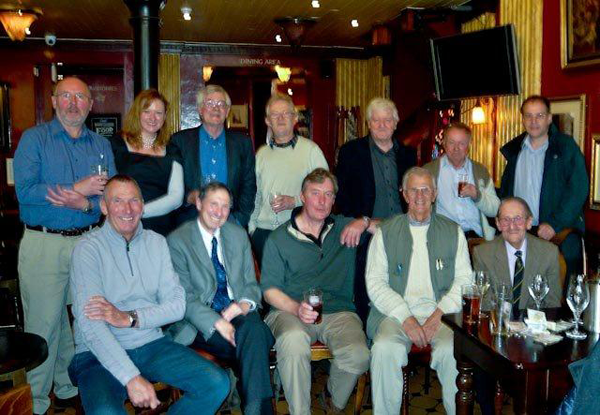
Peter Smith visited Fleet Street in the summer of 2012 and met up with a few friends.
“Hi Will good to hear from you. Yes we had a good turnout, any excuse for a drink, see attached, that’s me front row sitting fourth from left, I’m sure you recognise some of the other faces.”
